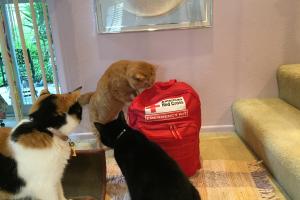This week is Disaster Preparedness Week. The above picture shows Sophee investigating the American Red Cross Emergency Kit. The most important thing in disaster preparedness is: HAVE A PLAN! Planning should include all of the 'what ifs' such as where you will be when a disaster hits. Will you be at home, at work, on the road or in another state? The options are considerable. At the time of the Northridge quake and the fire in 2008 that forced an evacuation, I was at home. These events predated the Cat Authors. However, the Cat Authors have experienced minor temblors because we do live next to the San Andreas Fault in Southern California. The experts say the “big one” is right around the corner. Our goal is to try to be prepared.
We, as pet caretakers, have to be prepared to take care of ourselves so we can take care of our pets. Thus, we need to maintain a supply of food and water. As a back-up, I purchased an Emergency Kit (is a red backpack) from the American Red Cross. Additionally, I strive to have mobile devices charged, duct tape, extra cash, important phone numbers, flashlights, a battery-operated radio to hear news broadcasts (learn what freeways have fallen and what roads are impassable) and gas in the car in the event of an evacuation.
If you do not have to evacuate, having a landline is very helpful. Immediately following the Northridge quake, the loss of electricity, downed cell towers and instantaneous heavy cell phone traffic made it difficult to complete any cell calls. Although it was 4:30 in the morning (still dark) I was able to work my way up the stairs (thanks to my flashlight), through the wreckage of my belongings and furniture that were launched and landed like rag dolls on top of each other in every room, locate the buried landline phone and place calls to relatives and those friends who were not so impacted by the earthquake.
The following is a suggested but not inclusive checklist for our cats:
- Make sure your cats are micro-chipped and wearing collars with ID tags that are up to date. The Cat Authors have ID tags with phone numbers & their names on breakaway safety collars.
- Prepare an emergency kit for the Cat Authors. This should include at least five days of provisions packed in a Durable Nylon Bag or secure plastic bin. The provisions should include at least the following:
- Cat food packets or cans
- Water pouches
- ER Emergency Light sticks
- Flashlight
- Water Purification Tablets
- Bowls (plastic bowls are lighter & less likely to break)
- Harness & Leash
- Cat toys
- Pet First Aid Kit (can be ordered online including at sunnydogink.com)
- Litter boxes, litter, litter scoop & bags to put pets’ waste in.
- Written information about feeding schedules, medications & medical issues.
- Current photos of your pets.
Additional considerations are:
- Know places where you might be able to board your pet or a hotel that might take you with your pets.
- Hopefully, neither you or your cats will be injured. But that is, unfortunately, always a possibility. A Pet First Aid Class will help you be a knowledgeable and confident pet parent. Denise Fleck teaches Pet First Aid classes (complete with animal mannequins) in Southern California. However, she has started an interstate teaching tour. You can check her class schedule at sunnydogink.com Additionally, her site offers an 'Ultimate Cat First Aid Kit' and a 'Deluxe Dog First Aid Kit.'
- If you have a room or area that you can designate as a safe room, put your supplies in there.
- Catch your cats as soon as the dust settles after the earthquake hits. A neighbor helped me corral my one cat at the time of the last earthquake. My cat, Tweedy, was terrified, horrified...and so was I. As soon as we cornered Tweedy, I put him in his carrier and put the cat carrier in the car because there were houses that caught on fire following the quake and I feared I would have to evacuate. Currently, my biggest nightmare would be catching the four Cat Authors…to put them in their carriers. They will be afraid and hiding and, of course, I am assuming (and hoping) that my house will still be standing so that the cats will still be inside the house and, of course, that none of us will be injured.
- If you evacuate, take your pets with you. Following Katrina, first responders will allow you to take your pets with you at the time of rescue and/or evacuation. It is understood, however, that there are circumstances where the only alternative is to save yourself.
There are online Disaster Emergency Kits (as found on the Humane Society websiste). As a back up, have some provisions for your cats (most cats are finicky eaters) so they will have the food that they are accustomed to eating. They will appreciate as much 'normalcy' as possible following the stress caused by a disaster.
Information for this article was obtained from the the following websites: sunnydogink.com; aspca.org/pet-care/; humane society.org redcross.org as well as my own experiences with natural disasters which predated the Cat Authors (Northridge Earthquke in 1994 and the Marek fire in October 2008).


Add new comment